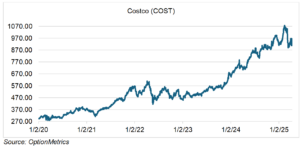Previous Panics
I was going to write about tariffs and economic policy uncertainty – yet again — this week, but decided that my readers might welcome a break. If you want to read about them, you won’t find any scarcity of articles on the subject, good, bad, and indifferent.
That being said, a word on previous panics, crashes, and downturns. Those looking to previous crises to help predict how the current crisis might play out should always remind themselves about the perils of drawing conclusions from extremely small sample sizes. So far, there have been only two crises this century. Even if the analysis is expanded to include previous centuries, the number of crises is still less than 20, and those that have proven significant (as measured by duration and peak to trough decline) amount to about five (the 1929 Crash, the Great Depression, the Dot.com Bust and Great Recession, the 1970s, and pre- and post-WW1). A sample set of five is hardly enough to draw solid conclusions. The most that can be said from this very small sample is that the market eventually recovered and went on to make new highs, but a definitive conclusion is not possible.
But…maybe the Tariff Crash is different and we have entered a new era of uncertainty-fueled de-risking? Having lived through my fair share of crashes over the years, I can say that traders tend to view the crash that they personally live through as the most severe in history. Personal biases comes into play and tends to distort one’s conception of the past.
Also, realize that the amount of news that you receive, and is readily available, is now orders of magnitude greater than in previous crises. This tends to amplify the severity of the current situation and reduces objectivity. For example, is the tariff crisis worse than the situation during the first weeks of the pandemic or during the height of the 2008 financial crisis? From the breathless and sometime apocalyptic news reports, you would think that it is far worse and that we are on the verge of Great Depression V.2.
Whether you believe that or not, the point is to try to remain objective and as detached as you can, regardless of how strident the headlines are.
One last point. Many of those shouting the loudest, especially among economists and financial commentators, have no discernable track record. Would you invest in a fund simply because the PM has a compelling shtick? No, you invest based on their track record. Personally, when I hear or read market commentary from economists, or political commentary from historians or political scientists, the first thing I ask is whether they have ever predicted anything with any degree of accuracy. And by accuracy, I mean what, how, and when. Unfortunately, the answer is almost always no.
Costco. Recession? What Recession?
For those of you old enough to remember, Peter Lynch was the manager of Fidelity’s flagship Magellan mutual fund and one of Wall Street’s first popular superstars. Frequently quoted in the press and on TV as a market savant, he was the Warren Buffet of the ‘80s. In his bestselling book, One Up on Wall Street, he made the case for buying stocks that you know from personal experience. Basically, like the product, like the service, like the stock. If its financial performance doesn’t measure up, then you can choose something else. The object is to produce a first cut on which stocks to buy based on your own experiences with the company.
Which brings me to Costco (COST). Yes, I know, I’ve written about the company and the stock a few times previously. I shopped there over the weekend, and just like every time I’ve ever been
there, the parking lot (which I’m pretty sure you can see from space) was almost full, the checkout lines were long, and the customers seem to be happy and buying lots of stuff. If I were completely cut off from the news, I would think that the economy was booming and consumer sentiment off the charts.
Of course, it could also be that we are still in the early days of a financial tectonic shift and that consumers are in denial, hoping that everything will calm down. Alternatively, people may be rushing to buy before tariff-induced inflation hits. Whichever it is, and if you’re thinking about venturing into retail, it would be prudent to select a company that is recession-resistant. Costco may very well fit that bill, providing cost-conscious shoppers quality products in a conducive atmosphere.
COST’s price behavior during the tariff panic is interesting (see chart below). Since March 31, it’s up 1.9%; compare that to the SPX, which is down 3.7%. Still, as of Monday’s close, COST is 9.1% lower than its almost $1077 high made on February 13. At the same time, and reflecting the general uncertainty in the market, its implied volatility has increased a full 7.4 percentage points since the beginning of the month and is currently trading at 30.5% (30-Day, 0.50 delta). If the broad market remains under control, expect it to decline back down to its pre-panic level of about 23%

Keep in mind that no company is immune in the short run to a full-fledged panic; sometimes, the best you can do is own something that goes down less than the market. But, in the case of Costco, the tariff panic might be presenting a buying opportunity and a recession hedge. That’s a pretty good combination.